Half-Life History

Image: Ivan Bakula .
Between the date of September 10, 2016 and October 10, 2007 - 3258 days. Between October 10, 2007 and November 8, 1998 - the same 3258 days. What is the significance of this calculation? The given date in 1998 is the day of the Half-Life release. The date of 2007 is the day of the release of Half-Life 2: Episode 2. More is elapsed since the release of the last of the existing games in the series than between the release of the first and the last games.
Valve has not finished the storyline of its first game, and there are no known plans to continue. Instead, the company prefers to engage in the game distribution service Steam, hats for a variety of multiplayer and virtual reality. Valve's last game was released in 2013.
')
To try to understand why this is happening, you need to dig into the very beginning of Valve. Below 1996, during the time of a completely different company.
Microsoft
From the late eighties, the Redmond company began to make good money on its software and grow furiously. Young Microsoft supplied MS-DOS and Windows operating systems, Word and Excel applications. De facto, Microsoft products quickly gained the title of standard for the IBM PC and business world. With the growth of the company, the fortunes of its founders grew. But not only the very first persons in the team got rich.

In addition to the four dollar billionaires, more than 12,000 millionaires came out of Microsoft. These were ordinary employees who received bonus options, company stocks. The first public offering in 1986 and subsequent periods of rapid growth meant that the state of such employees has grown dramatically. As a result, yesterday's students in a few days became millionaires. Many took wealth for granted.
The newly-made millionaires disposed of their state differently. The simplest is just to spend. Microsoft parking resembled an exhibition of expensive sports cars. It's even easier to lose. Someone donated part of a lawsuit for divorce with wives imported from somewhere in Eastern Europe. Someone thought that he had earned the money wisely, and ineptly invested it in, already later, the collapsed dotcom market. Someone lost on startups. Slightly more difficult to multiply money. Some were able to realize their plans to create new products and companies with the help of earned in Microsoft.
One of our heroes is the 271st Microsoft employee. In 1983, on the advice of Steve Ballmer, he left the prestigious Harvard University and spent 13 years at Microsoft. He worked closely on the first three releases of Windows 1.01, 1.02 and 1.03. The young man had great productivity: he could produce 30 products a year. But he left Microsoft to start his company. Gabe Newell wanted to make video games.
Newell realized from Doom that video games are the future of entertainment, according to Super Mario 64 that this is art. The original Doom came out under DOS in 1993. Newell installed it on the laptop. He walked around the office and showed everyone around him how exciting graphics could be compared to NES or the Sega prefix. It was Newell who contacted Carmack and offered to port Doom to Windows for free.
In the mid-nineties, Michael Abrash left Microsoft to work on Quake at id Software. The example was contagious. In 1996, Newell and Mike Harrington leave Microsoft to start their own company.
Windows
Today, the Windows operating system has become the center of the PC gaming ecosystem. If the game comes out on the PC, then it comes out under Windows - no further additions or explanations are needed anymore, everything is clear to everyone. The existence and exit of ports of games under OS X and Linux are a pleasant option, which is being talked about more and more often. But the main platform was and remains Windows.
So it was not always. By the time Windows 95 was released, it became obvious that the future of the OS will be largely determined by the set of games that will be released under it. At that time, Japanese companies dominated the gaming market: Nintendo, Sega, Sony. The American company needed a real atomic bomb that would allow it to win this war. And she was found.
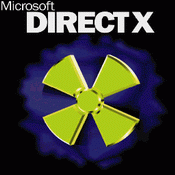 It's about the DirectX project. Today, Microsoft PR has diligently been silent that the first code name sounded like the Manhattan Project. As a result of the present Manhattan Project, the US gained a nuclear arsenal and successfully tested it on the cities of Hiroshima and Nagasaki, which was one of the reasons for the surrender of Japan. The name had to be changed to DirectX, because it promised problems with public perception. The nuclear past of the name remains in the logo and promotional materials for Windows 95.
It's about the DirectX project. Today, Microsoft PR has diligently been silent that the first code name sounded like the Manhattan Project. As a result of the present Manhattan Project, the US gained a nuclear arsenal and successfully tested it on the cities of Hiroshima and Nagasaki, which was one of the reasons for the surrender of Japan. The name had to be changed to DirectX, because it promised problems with public perception. The nuclear past of the name remains in the logo and promotional materials for Windows 95.Very loud sound.
In DOS, games accessed hardware directly, and Windows 95 introduced new levels of abstractions with protected memory access. The very first DirectX was needed to implement multimedia capabilities in Windows 95. Before that, there was already a similar project - WinG, which made porting DOS games more simple. It took time to convince developers to switch to what looked like a replacement for WinG, which could also be replaced in the future.
All this happened after the release of Windows 95, in the mid-nineties of the last century. It was the era of a slow transition to angular 3D-games. Their graphics looked like some Minecraft and other modern indie with retro graphics. Only in the nineties, the polygons and the primitive effects of lighting inspired no sense of nostalgia, but real admiration. New genres appeared and developed, network multiplayer developed.
All this lives and runs on personal computers with early "Pentium" with the frequency of work rarely when above a hundred megahertz, RAM in dozens of megabytes, and sometimes even with video accelerators with megabytes of memory. The living room is ruled by the PlayStation, Nintendo 64 and other fifth-generation game consoles. A characteristic set of first-person hits in the mid-nineties: System Shock, Doom II, Quake, Duke Nukem 3D, GoldenEye 97.
Valve
Newell and Harrington are completely unknown names in the game development world. Worse, the two did not know how to make video games. And the plans were ambitious. Gabe and Mike chose a technically challenging 3D game with action elements.
Michael Abrash, who left id Software, proposed licensing a new engine that he developed with John Carmack. Harrington and Newell went to Texas, to id headquarters. And it is easy to imagine what reception they expected there. The coolest video game company at the time was hit by two developers who could boast names under Windows NT, OS / 2 and Microsoft Bob projects. Yes, they had money. But is it worth working with them on an equal footing?
Abrash vouched for his friends, which helped the future Valve a lot. Newell and Harrington learned a lot about how the gaming industry works as a result of communication with id Software. It was in Texas that they received contacts for access to interesting developers. In the plane back to Seattle flew and a disk with the source code engine Quake. But no one in the company, except Abrash, believed that the two of them would ever return.
August 24, 1996 Newell marries. On the same day, Valve was founded, at that time an overly ambitious and unknown studio of video games. The Balvos have been renting out a five-year office in Kirkland, a quiet town near Seattle. The very name of Valve stands out among the companies of video games of the time: nothing extremely aggressive, even something faded. Another version of the name, which was almost chosen, sounded like the Hollow Box (empty box).
In the empty box was already the engine and a couple of ideas. Next followed the hiring of developers. Here, Valve entered the original: the company scored modders and developers, fans. For example, Steve Bond and John Guthrie, the authors of the Quake Command fan site, received a letter from Gabe. At that time, Guthrie was in college and worked as a pizza delivery man. After a visit to Seattle, Bond joined Newell's company, and a week later he left school for Guthrie: he also wanted to make games at Valve.
There were problems with this approach. I had to filter out quite a few Quake fans who poorly represented the future of the genre. And many of the new employees have never worked anywhere before. They needed help to gain a foothold. In addition to the inexperienced modders, Valve hired several industry veterans from 3D Realms, Shiny Entertainment and Microsoft.
To distribute and sell the game you need a publisher. And with this, too, there were problems. For the former respected maykrosoftovtsev was a novelty negativity and distrust of an unknown studio to anyone. Many publishers simply expelled young Valve, not believing in her promises. For example, a meeting with one of the publishers was quite adequate. But after Valve's promise to use skeletal animation in a future game, the publisher immediately ended the meeting.
Valve was lucky to stumble upon Sierra On-Line, the publisher who was just looking for a product on the Quake engine. At the right moment, Niella received a letter from Sierra, who said that they had a license for the engine and a team of former Microsoft employees. Sierra founder Ken Williams was intrigued. In the early nineties, he had a chance to buy id Software, which he missed. And now he realized that Sierra is lagging behind the genre of 3D games.
On the appointed day it was snowing, which happens infrequently in Seattle and therefore causes a collapse of the transport system. Somehow, the Balvos got to a completely empty office building, where only Ken was, and started their pitch. After 20-30 minutes, when it only approached the final of the presentation, Williams interrupted the presentation and agreed to cooperate.
Later, he will tell you that he made a decision, because the other teams were a bunch of artists and designers, but not engineers. In Valve, the engine was the starting point, not the end. At the same time, the company was going to not just nastrogat maps, and create a story and a unique world.
Prospero
In the early years of its existence, Valve simultaneously created two games. One of them is Prospero. It was supposed to be a science fiction project with a focus on exploring a unique world and a complex plot. In July 1997, writer Mark Laidlow was hired to work on Prospero. The second game is Quiver, Doom level corridor shooter, whose goal is adrenaline and player entertainment.
Quiver changed its name to Half-Life and became one of the most successful games in history. Project Prospero never saw the light. About him there is only a fragmentary information from the sayings of the developers and the page in the Half-Life 2: Raising the Bar.
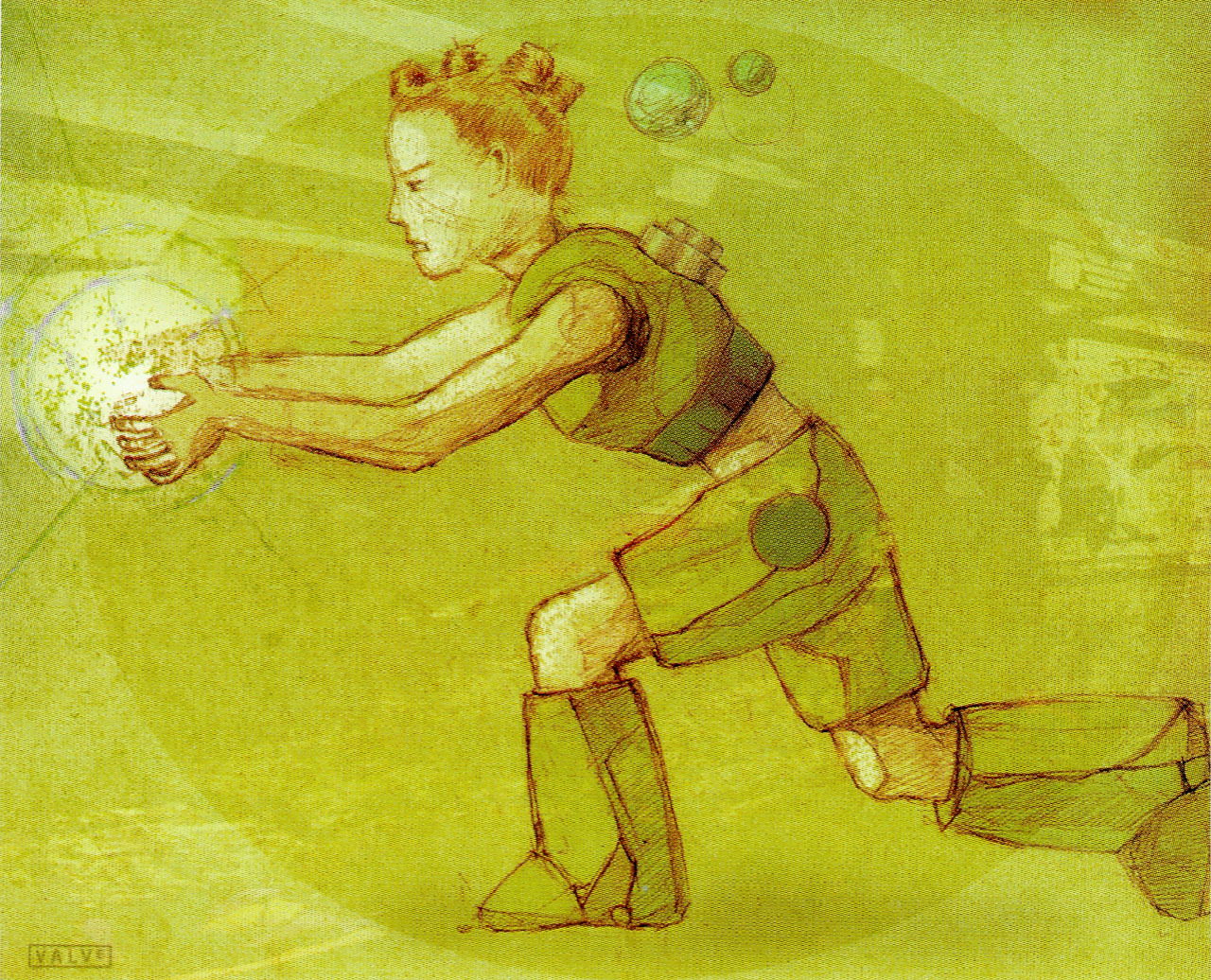
The main character in Prospero is someone Aleph or Aleph-Null (a possible reference to set theory ), also known as the Librarian. She uses her psionic abilities to fight against enemies. In one of the variations of character development, she relied on devices to enhance and improve her own abilities.
Initially, Prospero was supposed to be a third-person adventure quest created under the influence of the game Myst and the work of Jorge Luis Borges . Third-person view was needed to give the player a sense of scale. And if there is a Librarian, then there must be a Library: by this in Prospero is meant a catalog of worlds into which Aleph may enter.
As the concept evolved and some of the ideas entered the Quiver project, it became a massively multiplayer online game. Technically, each of the worlds would have to be hosted on a separate server. In the Library it would be possible to find both user worlds and those created officially. The game had planned lists of friends and a server browser. The storyline concept with access to the worlds vaguely recalls Borges's story "Aleph", describing a point in space that contains all other spaces.
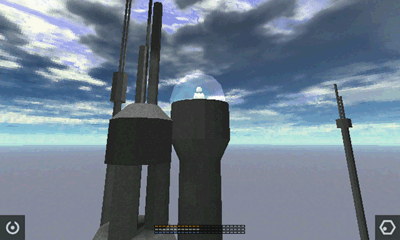
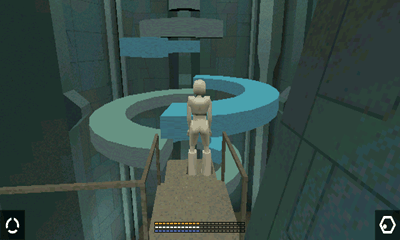
Hand Library Sketch by Randy Landin . Noticeable minimalist interface.
Publicly Prospero is poorly known. There are only a few screenshots and rough sketches of characters. Work on Prospero led at least from August 1996 to October 1998. Laydlow had to digress only for a couple of weeks to reinforce the plot of Half-Life, and then continue working on Prospero. But in the end we know him first of all as a script writer of the Half-Life series.
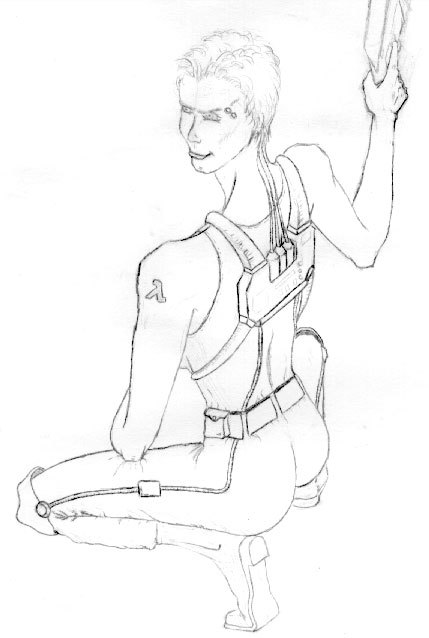
Miranda, another character in the game. The name is probably a reference to Shakespeare's play The Tempest , where the magician Prospero had a daughter, Miranda. The symbol on the tattoo did not disappear: the lambda later became part of the world of Half-Life.
Prospero ideas were taken to other works by Valve. The server browser is a standard feature of multiplayer games on Source and GldSrc. The friend lists and directory of levels that users have created are the Steam Community and the Steam Workshop . Prospero has stepped far ahead of its time: Carl Dekard's resume mentions that Prospero content was used in the Portal game series, where there really is a separate level designer.
If you look into the standard Half-Life assembly, you can find files that are related to Prospero. Several tracks of the game’s music are called prospero01, prospero02, and so on, which indicate a possible belonging to another game.
Once in Valve they said that they would like to return to Prospero someday. But hardly now it makes any sense - everything that was in the project, Valve has already implemented.
Quiver
While searching for ideas for a future game, the team became interested in Stephen King's story "The Fog". In the book, the city of Bridgeton in Maine envelops an unnaturally thick fog in which monsters are hiding. The main character and his son are trying to hide in the supermarket and fend off danger. Its cause is a certain military project “Arrow” (“Arrowhead”). Of course, the idea with the supermarket was omitted, but the details of the psychological horror genre were used. From the story of King and came the code name of the game - Quiver (quiver).
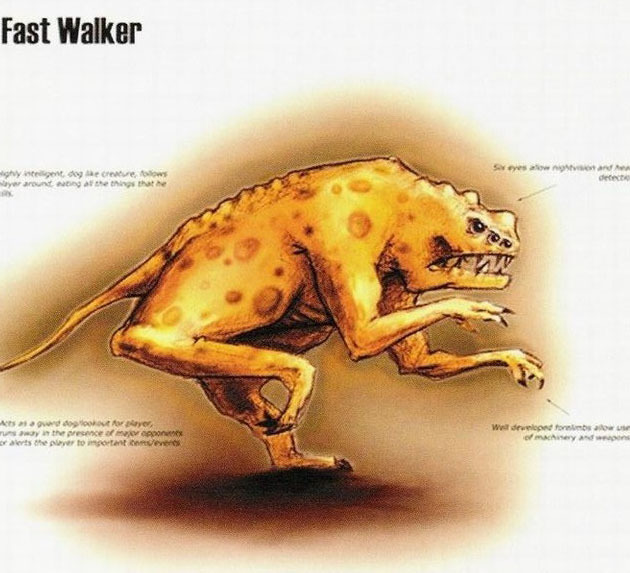
Fast Walker behaves like a dog: follows Gordon, feeds on the meat he shoots and helps in the game. The creature did not make it to the final game.
The team threw enemies and the plot of what made Half-Life. Some of the creatures survived to the final game with almost no changes. The other part has undergone significant alteration, sometimes completely cut out. Even the most beautifully drawn creature does not fall into the game, if he does not have a clear behavior in battle and competently written AI.
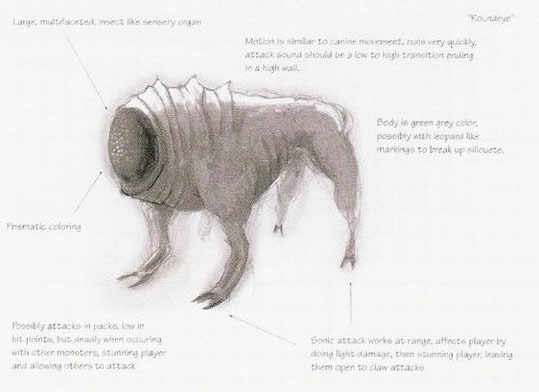
The final houndai is very similar to the first sketch. His anatomy Ted Backman drew in the image of the huge three-legged cat Tripod, which the artist remembered from childhood.
Valve had ambitious plans for a future game that went beyond the original Quake engine. For example, I had to somehow work with computers of that era in order to provide the necessary level of animation quality. Two decades ago, advanced technology was skeletal animation. And in that era, programmers managed to surprise the rest of the staff with the fact that people's mouths open to the beat of speech.
Half-Life Artificial Intelligence is smart for its era. Probably the most famous demonstration of his power is the behavior of cockroaches. They run off to eat, afraid of the sudden inclusion of light and large creatures. And these are just auxiliary creatures that can be ignored without loss for the gameplay. Enemies in Half-Life work together in flocks. Monsters wander and eat something. In fact, relative to Quake, the enemies artificial intelligence was written from scratch.

Mr.Friendly had to knock the weapon out of the hands of the main character and throw him to the ground. As Ken Birdwell recalls, the monster was invented by the son of his friend, whom he recommended Valve as an artist. Among the works in the portfolio was this monster with a prominent member. At the demonstration, Newell directly asked what was there sticking up. The artist said that he thought that scares the target audience - 14-year-olds. And they saw enough of horror movies with guns instead of hands. Therefore, Mr.Friendly should induce a homophobic reflex with appropriate behavior. This was followed by a description of the idea of posthumous sexual intercourse. Gabe was staring a little more, and then praised the artist and entered into a stormy discussion with him about the possible psychosexual relationships of newcomers and the clinical descriptions of teenagers' sexual fantasies. All this happened in the presence of Birdwell.
In Half-Life, 3D models are more detailed than in Quake: the engine supports more polygons. In the game Valve added support for transparent textures, which allowed to place in the game glass of different colors. In Quake, the light was exactly the same color. In Half-Life, the lighting can be of different colors.
In general, it may seem that there are not so many changes regarding the original QuakeWorld. The Half-Life engine is written in the same C. In Half-Life in C ++, the logic of the game is written, in Quake, the specially created Quake C language is used. In the Valve engine, about 50 (in other sources, no more than 100-200 lines) are included Quake 2, mostly a variety of bug fixes. The mapping tools are similar, the rendering architecture is the same as in Quake. Is that the lighting is not 8-bit with a fixed palette, and RGB.
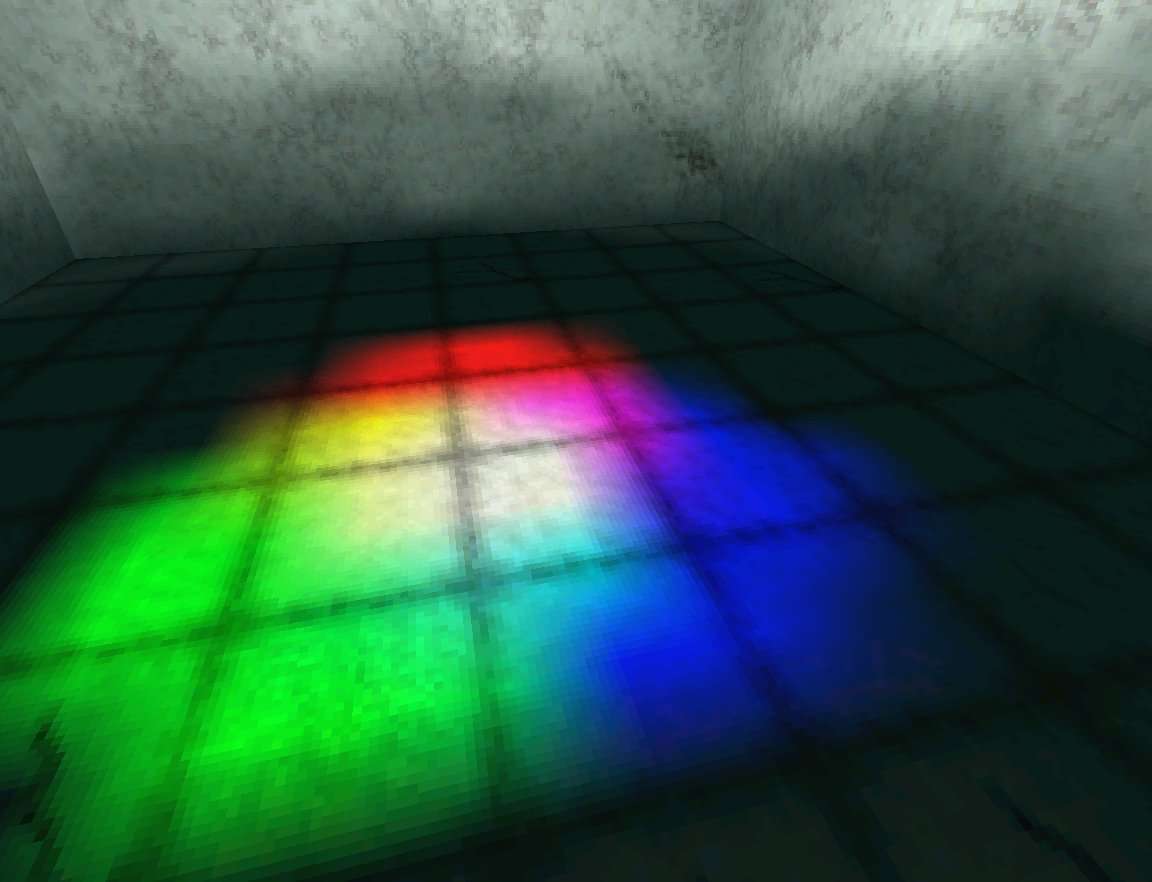
Mixing colors in the Half-Life technical demo.
Similar .WAD files for storing patterns and textures. In Half-Life, each texture has the opportunity to have its own palette. Quake uses WAD2, Half-Life - WAD3. In general, the WAD format goes back to the original Doom. The Half-Life .BSP card format is so similar to the BSP Quake format that early versions of the Hammer editor could open and edit Quake and Quake II maps. Later, official support for this disappeared, although it can still be returned. However, this is not surprising: Hammer began as a Quake map editor from ACD Systems, was called Worldcraft and sold for $ 35. Valve bought the rights to the editor and developed it to Hammer.
In Half-Life, software rendering is 16-bit, not 8-bit, as in Quake. This improvement required only minor changes to the code. In the engine, there was support for marking-decals, there are several improvements in the audio system. At the time of the release in Half-Life, the multiplayer network code was identical. In 2001, it was completely rewritten and added lag compensation. In general, the engine is rewritten by 70%, although if you dig, you can find large fragments of unchanged code.
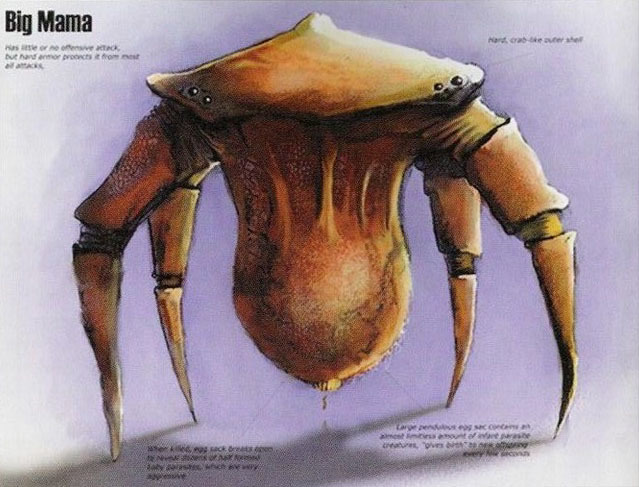
Gonarh - the final stage of the development of the head of the head. In fact, it is a testicle on spider legs.
The very name GoldSrc will appear later. At the time of development, the engine inside the company was not called. In computer magazines of the time, the Half-Life engine is described as Quake Unified Technology. By the time Half-Life was released, two branches of the engine's development appeared: the stable GoldSrc, which had gone to gold, and the experimental Source. Initially, code names were so entrenched that they became the official names of engines.
First Demonstration at E3 1996
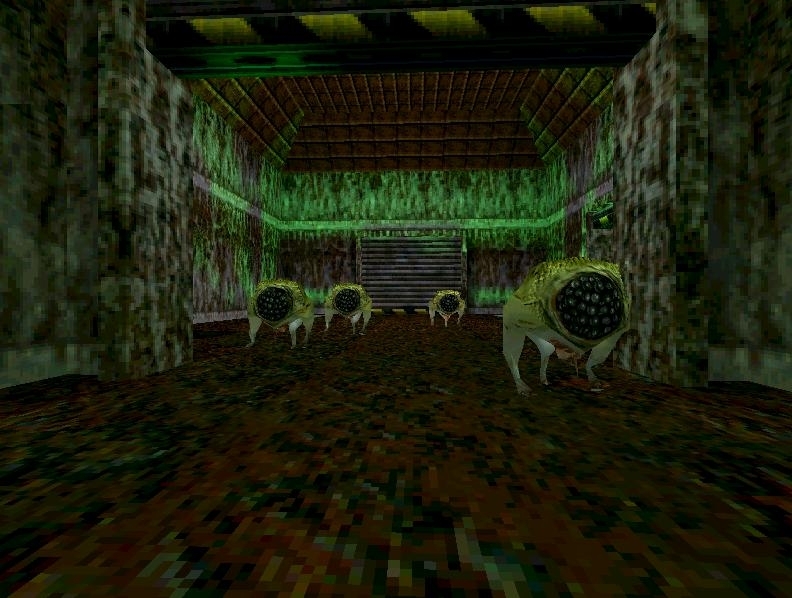
The second screenshot is Half-Life.
When Sierra announced the new development of Valve, some screenshots of disgusting quality were released. They have the Houndans captured in the rooms. A real demonstration of skeletal animation, good AI, and a general level of graphics was conducted only at the 1997 Electronic Entertainment Expo.
In those years, the term "first-person shooter" has not yet won a place in the English language. Half-Life games were called “Doom clones,” which, in general, was not far from reality. The public was able to see the next hit on E3 in June 1997 for the first time. The demonstration was a success, and Half-Life even received an award for being the best game of the exhibition. Indeed, Valve’s work looked good against a variety of Quake imitators.
Half-Life was supposed to keep up by November 1997, just in time for the holidays. The attention of the public and the awards were already before the release. It would seem that further can go wrong?
Early alpha version of 1997.
The problem was only in one: the game did not exist. In August, Laydlow was drafted to design, so that he at least did something with the characters, storyline and level design. By September, much had been done, only a good game did not work.
With all the efforts of artists and programmers in many places, Valve obtained a total conversion of the original Quake. That is, a new game created on the same engine with the complete replacement of all original resources. And she inherited the original gameplay too much.
Yes, there were horrendous monsters, but if in a battle a player deviated from the planned by the developers, the foes were stupid. There were maps and levels, but they combined poorly with each other. There was a good engine with advanced graphics, but its coolness was present only in a couple of places. In Half-Life of that period there were good moments - it was just that the games did not work.
Programmers added new features, proudly reported this to designers, and then were surprised to see that functions were not used anywhere. For example, in the engine appeared the effect of "rays", in fact - beautiful lines of electricity, lasers, energy, light between two points. E-mails to the right employees fell letters explaining the parameters of the effect. Two months later, only one designer took advantage of the effect. The naive assumption “make and use” did not work.
Demonstration of gameplay early version of the game. This is the gluing together of separate fragments of recorded demos inside the leaked alpha.
If Valve was completely away from its publisher, it would take a few more months to work on the most obvious problems and release the resulting. It is clear what sales it would lead to. And for a young studio, the weak result of their first project often means closure. Fortunately, Valve existed on the money of its founders. To issue a salary, Gabe wrote a check from a personal checking account.
Risking their relationship with the publisher, Valve postponed the release of the game. Sierra had high hopes for the project and at that time was already preparing an advertising campaign for the game, but still endured it.
The first year of her life, Valve just learned to make a game. Almost all the resources created during this time were sent to the scrap. Work began from the beginning. Oddly enough, the morale of the team all affected positively, not negatively.
Out of desperation, all the working ideas, all the successful weapons, all the scripted events, all the good features of level design were put together in one map. A month a separate group worked on this level, while the rest did almost nothing. When the level was ready, he was rated. It was a success: it was the vision that was needed for the final game. The only thing is that Valve needed to make about a hundred more of these levels.
The studio conducted an analysis of why this level works. It turned out a few theories. One of them said that the matter was in the density of events per unit time of the game. When advancing, a player should never wait too long for the next interaction with the game, and too many events in a short amount of time tire. The speed of issuing events depends on moving forward, not time. If a player wants more pressure from game events, he will simply move faster.
Another theory: the game must perceive the player and his actions, otherwise the player will not perceive the game. If a player fires a weapon, there must be something other than the sound of a shot. Designers would like to be able to make a hole in the wall, but technically this was not feasible. We stopped at the decals. If the player pushes what should be pushed, the object must move. If a player enters a room where someone is already there, they should react to it or at least look at it.
Cabal
The first 11 months of work Valve tirelessly looking for the official "game designer" - a man who will come and put everything on the shelves. The company reviewed hundreds of resumes and interviewed many, but the magic wands were not found. It became clear that the ideal person does not exist. I had to do everything myself. To do this, they created a group called Cabal by the name of the “ bonded ” council under Charles II.
The aim of the work was to create a document that fully describes all levels, interactions with enemies, their behavior, weapons and plot moves. It was necessary to understand when each type of enemy and weapon is introduced, what skills the player should already have when taught him.
Meetings of the Cabal group looked like a semi-organized brainstorm on a limited game area. Someone fixed one idea to which the group came, someone else sketched sketches of levels. After collecting enough ideas, the group created a rough form of the future plot.
Whole levels for some time described the general words "on the surface" or "something with a big monster." Sometimes ideas were suspended for a long time - some zones were created without a certain place in the game. Sometimes they were cut out, sometimes added somewhere. Sometimes the segments of the levels were created with the aim of showing the good functions of the engine or the good geometry of the fragment of the pre-cabal period. Gradually, the habit of throwing a few unrelated requirements developed, and then adjusting the level to them. <3
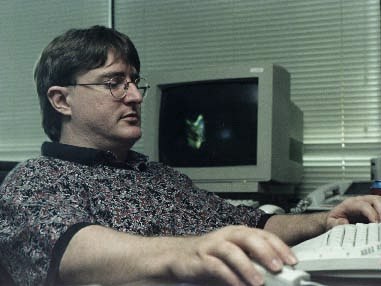
For five months in a row, four days a week, six hours a day, the Cabal group sat and created the document. After six hours of such work, the group members were completely exhausted. The only thing left for them was to check the mail, they did no other work. Later, the council was again sometimes convened on an irregular basis.
The original group consisted of three programmers, a level designer, a writer and an animator - representatives of each of the main castes in Valve Software. Once every few weeks they rotated and changed participants, but so that there were representatives of different departments.
The result was a 200-page document, which described the details from the height of the buttons to the time of day at the level. However, his elaboration is still not enough to play this length. When we talk about Half-Life, it is worth remembering that this is a project of the late nineties. It takes a few dozen hours.
Already by the second month it was written enough to create levels. By the third month of work, Cabal began testing. Sierra provided volunteers who came to Valve and played for two hours. Behind each of them sat silently a designer of this level and a member of the bonded council who proposed this segment of the game. You can imagine the irritation from the observation of how the tester for twenty minutes is dug into that fragment that seemed obvious at the design stage.
In total, more than 200 PlayTest sessions were held, each of which resulted in approximately one hundred items of changes. Toward the end of development, something like gameplay has already appeared. The behavior of the players was recorded, then the position, health, weapons, speed of passage were analyzed. The health charts of the player made it clear which fragments are too simple or complex, in which places there are few interactions, and that’s why it's boring.
Spent process helped finish the game. Almost everything in the game was created by bonded advice. The work of the group not only helped to create, but also to remove weaknesses. The process of playtests avoided the personal nature of such decisions.
Half-Life: Day One
In June 1998, at the next E3 project demonstrated again. Again, Valve received the exhibition's game award, although there was no game yet. The creation process was already underway, it was necessary to finish it. The next few months, the studio worked in emergency mode. Sometimes employees worked for days without a break, just to be in time for deadline.
The dates first moved in the spring of 1998, then in the summer, September, Thanksgiving in October. Sierra was already joking that the mythical Half-Life never appeared on the shelves. The work went on, even if many features disappeared from the game. Among them: individual marks of shots on the bodies, a manned helicopter with control is not worse than a typical aircraft simulator and much more.
For the first time, the game came out in the form of a demo version of Half-Life: Day One. As the name suggests, it contains the plot of the first day of the events of the Black Mesa research complex. Day One was not available to everyone - it was a special version complete with video and audio cards. But the demo was quickly posted on the Internet. By September, it was downloaded by many, and even then it was called one of the best 3D games. As John Carmack recalls, it was only then in Texas that Valve did it all. John Romero said that he swallowed the whole demo in 4.5 hours.
In early November, the developers closed the last bug and made sure that not a single file was forgotten in the game. Valve employees who have already become accustomed to 24-hour working days were sent home, and in some cases to their wives. Everyone was waiting for the test results in the Sierra. On November 7, a cherished letter arrived by e-mail: the game entered gold and was launched for replication. On November 8, 1998, Half-Life finally came out.
Fashion and community
The game with the chapters and mount sold millions of copies. By 2004, eight million copies had been sold. To this day, Half-Life remains on the list of best-selling history games. More than 50 editions called Half-Life the game of the year. It is not difficult to see the reason for success: it was one of the first games that was not an interactive shooting gallery. Half-Life and its softly stitched cards told the story, immersed the player in the fictional world, and not just made it possible to shoot enemies. The game has changed the industry: many critics divide the game into an era before Half-Life and after.
Valve's story does not end there. Of course, the studio began work on a sequel, and they expected a breakthrough from it no worse than the first part. The original was ported to game consoles, and Gearbox Software issued the rights to develop spin-offs in the Half-Life universe. At the same time, Valve did not forget its roots.
Two former Microsoft employees created operating systems, environments in which users ran their own applications. And to work in Valve were hired modders, members of the community of gamers who created new content by modifying existing games. Attitude to the similar phenomenon then was ambiguous. Someone supported him and gave out development tools, someone at best did not prosecute.
And there is nothing surprising that Valve created not just a game, but also an environment in which new masterpieces were born. This is not just about licensing the engine GoldSrc - there were such deals. Ordinary users also created their non-commercial projects. Only Mod DB has over 700 Half-Life mods. There are thousands of individual cards.
The teenager was expelled from school for creating a school card in Counter Strike and they searched his house. 2007
Among the mods there are not only amateur crafts, but also projects that have developed into serious games.
For example, Counter Strike began as a mod, but its popularity was noticed in Valve. Team Fortress Classic itself is the port of the original Team Fortress, which was created for Quake. Day of Defeat began as a Half-Life mod that carried the player into the atmosphere of the Western Front of World War II. In all these cases, Valve, sometimes even before a period of stormy fame, noticed success, bought out the rights and hired a model. And in all three cases, the amateur project was honed to the popular game, which is sold in millions of copies. Some of the games even surpassed the original Half-Life: more than 12.5 million copies of the original Counter Strike were sold. To this day, people continue to play in the 2000 version.
Valve . — . , , Half-Life. HL2 . 2004 , . .
( 1 , 2 ), , Business Insider , ComputerAndVideoGames.com , Forbes , GameSpot Gamasutra .
Source: https://habr.com/ru/post/397867/
All Articles